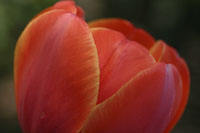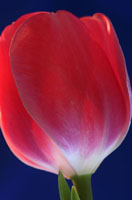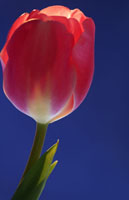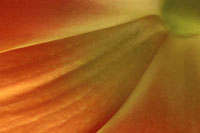From: caroleigh@c...
Date: Mon Feb 14, 2005 3:13 pm
Subject: Critique: CJ Middendorf (Lighting - 4 photos)
Tulip (first two) - Good close-up composition here, CJ.
You filled the frame nicely and the background is clean and not intrusive.
Look at how much more colorful the flower is in the diffused photo than
in the non-diffused photo. Why? Because tulip petals are shiny. With no
diffusion and bright sun, there are glaring hot spots in the sunny areas
and dark spots in the shadowy areas. Any time you have hot spots and shadows,
you DON'T have color, so your photo (which in this case is emphasizing
color) has much more impact when you diffuse and soften the light. Could
you have used a polarizing filter instead of a diffusion disk and gotten
the same effect? A polarizing filter is great in bright sunlight for reducing
the amount of reflectivity off of shiny flower petals (and fall leaves,
too, but I digress . . .). I may get rid of some of the glare, but I don't
think it would have had the same soft effect on the flower.
IT'S SUNNY HERE RIGHT NOW. I'M GOING TO GO OUTSIDE AND TEST THIS OUT MYSELF.
I'LL BE RIGHT BACK . . .
From: caroleigh@c...
Date: Mon Feb 14, 2005 3:42 pm
Subject: Critique: CJ Middendorf (Part 2)
Critique: CJ Middendorf (Lighting - 4 photos)
Part Two of Two Parts . . .
Tulip (first two) - Could you have used a polarizing
filter instead of a diffusion disk and gotten the same effect? A polarizing
filter is great in bright sunlight for reducing the amount of reflectivity
off of shiny flower petals (and fall leaves, too, but I digress . . .).
It may get rid of some of the glare, but I don't think it would have had
the same soft effect on the flower. Nah, it didn't work nearly as well.
There was a little reduction of glare, but not very much.The color seemed
a bit richer, but nothing like how it looked with the diffusion disk.
Now the polarizer AND the diffusion disk might be a nice combination,
but it's windier than a son of a gun right now out there and it's COLD!
So let's move on . .
.
Tulip with Backlighting - I think you're absolutely right.
The lighter, whiter spot there at the bottom of the flower is where my
eye goes and it's just not working. The petals on the left are sort of
clipped, too, which doesn't help your composition much. Tulips are rather
dense flowers and so don't lend themselves to backlighting UNLESS you're
willing to remove the front petal. By ripping off that front petal (ouch),
you open up the flower where you can see not only the interesting "guts"
of the flower, but you can also capture the light coming through from
the back. If you cut your tulips and bring them indoors, watch as they
slowly open up and then gently remove one of the petals to give you access
to the flower's interior.
Looking forward to seeing more of these . . .
Carol Leigh




